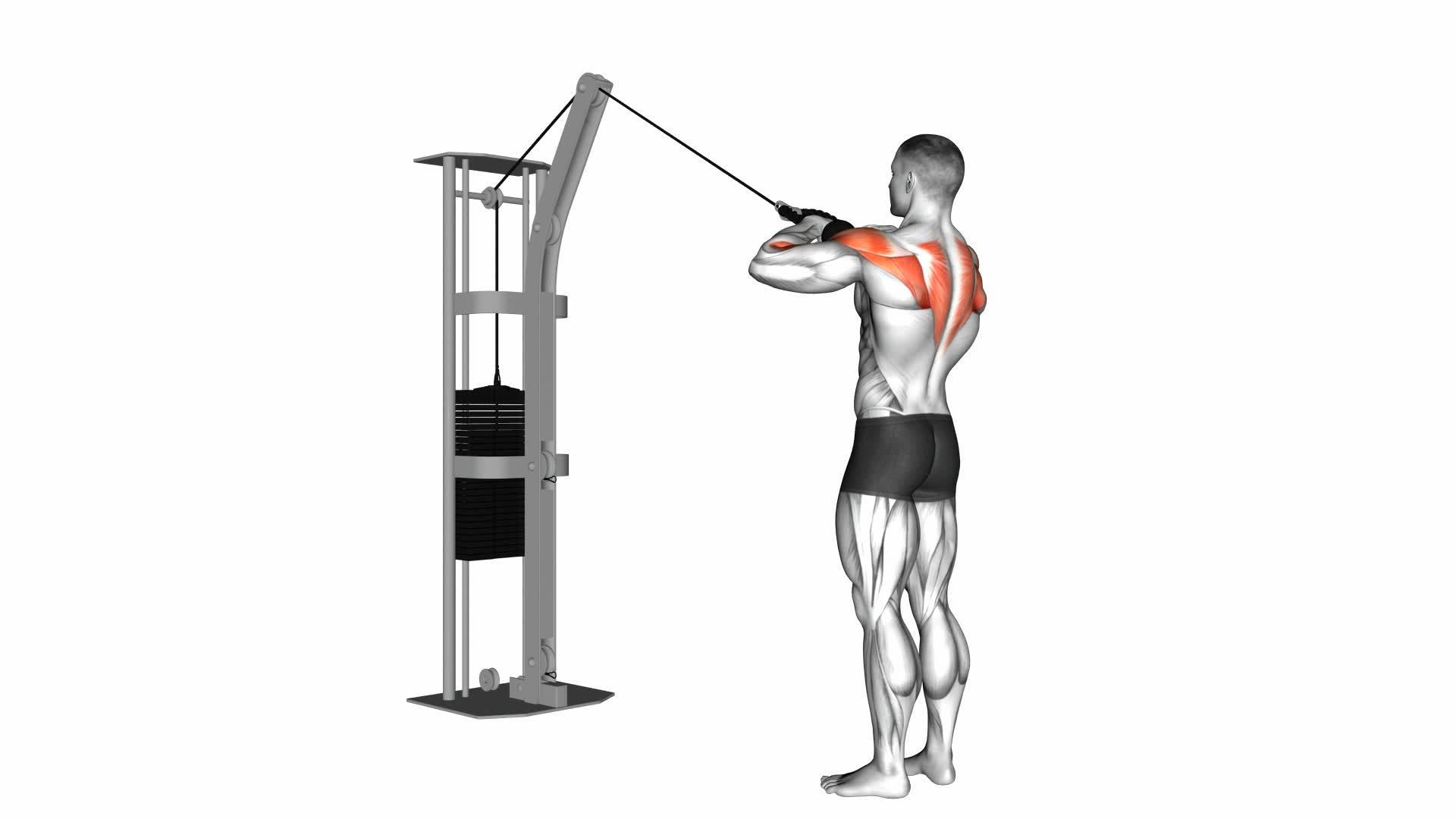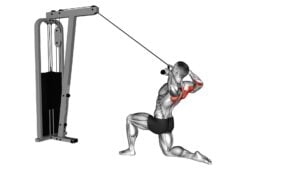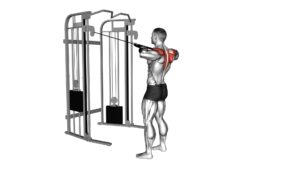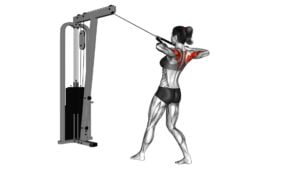Cable Rear Delt Row (With Rope) – Video Exercise Guide & Tips

In this video exercise guide, you'll learn how to perform the cable rear delt row with a rope attachment.
Watch This Exercise Video
This exercise targets your rear delts, helping to improve your upper back and shoulder strength.
You'll need a cable machine and a rope attachment for this exercise.
Follow along as the video demonstrates the correct form and provides tips for proper execution.
Get ready to strengthen and sculpt your shoulders with this effective exercise.
Let's dive in!
Key Takeaways
- Cable exercises provide a smooth and controlled movement, increasing muscle activation and growth.
- Using a cable machine is a safer alternative to free weights, reducing the risk of injury.
- Cable exercises offer a wide variety of movement patterns that target different muscle groups.
- Proper form and technique, including maintaining a neutral spine and squeezing shoulder blades together, are essential for maximizing the benefits of cable rear delt row.
Equipment Needed
To perform the Cable Rear Delt Row (With Rope) exercise, you'll need the following equipment. First and foremost, you'll need a cable machine with a low pulley attachment. The cable machine allows for smooth and controlled movements, making it ideal for this exercise. Additionally, you'll need a rope attachment. The rope attachment provides a comfortable grip and allows for a greater range of motion during the exercise.
Using cable exercises, such as the Cable Rear Delt Row, offers several benefits. Firstly, cables provide constant tension throughout the movement, which can help increase muscle activation and promote muscle growth. Secondly, cable exercises allow for a wide variety of movement patterns, allowing you to target different muscle groups from various angles. Lastly, cables offer a safer alternative to free weights, as they reduce the risk of injury by providing a controlled and stable environment.
While there are alternatives to cable exercises, such as dumbbells or resistance bands, cables offer unique advantages that can't be replicated. However, if you don't have access to a cable machine, you can still work your rear delts using alternative exercises like bent-over dumbbell rows or reverse flyes with resistance bands.
Now that you understand the equipment needed for the Cable Rear Delt Row (With Rope) exercise and the benefits of cable exercises, let's move on to the starting position.
Starting Position
To get into the starting position for the Cable Rear Delt Row (With Rope) exercise, follow these steps:
- Stand facing the cable machine with your feet shoulder-width apart.
- Grab the rope handles with an overhand grip, palms facing each other.
- Keep your arms fully extended and slightly bend your knees to maintain a stable base.
- Engage your core and maintain proper posture by keeping your chest lifted and your shoulders relaxed.
It is crucial to avoid common mistakes that can prevent optimal muscle activation during this exercise. Here are two mistakes to watch out for:
- Using too much weight: Using too much weight can compromise your form and lead to ineffective muscle engagement. Start with a lighter weight and gradually increase as you become more comfortable and confident with the movement.
- Pulling the rope handles too far back: Pulling the rope handles too far back can cause excessive strain on your shoulder joints. Instead, focus on pulling the handles towards your midsection while maintaining a controlled motion. This will ensure that your rear deltoids, rhomboids, and middle trapezius muscles are properly activated.
Execution
Grab the rope handles with an overhand grip, keeping your arms fully extended and palms facing each other. Stand facing the cable machine with your feet shoulder-width apart and your knees slightly bent. Engage your core and maintain a neutral spine throughout the exercise. Begin by retracting your shoulder blades and pulling the rope towards your body, leading with your elbows. Keep your elbows close to your body and squeeze your shoulder blades together at the end of the movement. Slowly return to the starting position, maintaining control and tension in your muscles.
When performing the cable rear delt row with a rope, it's important to avoid common mistakes to maximize the benefits of the exercise. One common mistake is using excessive weight, which can compromise your form and lead to injury. Start with a lighter weight and gradually increase as you become more comfortable and confident in your technique.
Another mistake is using momentum to complete the movement. Remember to focus on controlled and deliberate movements, emphasizing the contraction of your rear deltoids. Finally, avoid rounding your shoulders or hunching forward during the exercise. This can shift the emphasis away from the targeted muscles and increase the risk of injury.
Tips for Proper Form
Maintain proper form and maximize the benefits of the cable rear delt row by following these tips:
- Avoid using excessive weight: One common mistake is using too much weight, which can lead to poor form and increase the risk of injury. Start with a weight that allows you to maintain proper technique throughout the exercise.
- Keep your back straight: It's crucial to maintain a neutral spine throughout the movement. Avoid rounding or arching your back, as this can put unnecessary stress on your spine and reduce the effectiveness of the exercise.
- Squeeze your shoulder blades together: To target your rear deltoids effectively, focus on squeezing your shoulder blades together at the end of the movement. This will ensure that you engage the correct muscles and maximize their activation.
- Control the movement: Instead of rushing through the exercise, focus on controlling the weight throughout the entire range of motion. This will help you maintain tension in your muscles and prevent any swinging or momentum.
By following these tips, you can avoid common mistakes, target your rear deltoids effectively, and reap the benefits of the cable rear delt row.
Remember to always prioritize proper form to maximize the effectiveness and safety of your workouts.
Variations and Modifications
Now let's explore some different ways you can modify and vary the cable rear delt row exercise. By making modifications to this exercise, you can target different muscle groups and maximize the benefits.
One variation of the cable rear delt row is to use different attachments such as a V-bar or straight bar instead of the rope. This allows you to change the grip and engage your muscles in different ways.
Another modification is to adjust the height of the cable pulley. Lowering the pulley will increase the resistance and challenge your muscles even more.
To target your upper back and rear deltoids, it's important to maintain proper form and avoid common mistakes. One common mistake is using excessive weight, which can lead to improper technique and strain on the muscles. To avoid this, start with a light weight and gradually increase as you become more comfortable and confident in your form.
Another mistake to avoid is pulling the rope too far back, which can cause excessive tension on the shoulders. Instead, focus on pulling the rope towards your chest while keeping your elbows close to your body. This will ensure that you're targeting the correct muscles while minimizing the risk of injury.
Incorporating variations and modifications into your cable rear delt row routine can help you target specific muscle groups and avoid common mistakes. Remember to always listen to your body and adjust the weight and form accordingly.
Frequently Asked Questions
How Many Sets and Reps Should I Do for the Cable Rear Delt Row Exercise?
To determine the number of sets and reps for the cable rear delt row exercise, consider your fitness goals and current fitness level.
Cable rear delt row variations can target your rear delts, upper back, and shoulders.
It's important to start with a weight that challenges you but allows for proper form.
Aim for 3-4 sets of 8-12 reps, with a rest period of 60-90 seconds between sets.
Adjust the weight and reps as needed to continue challenging your muscles and promoting growth.
Can I Perform the Cable Rear Delt Row Exercise Using a Resistance Band Instead of a Cable Machine?
Yes, you can perform the cable rear delt row exercise using a resistance band instead of a cable machine. This alternative equipment still targets your rear deltoids effectively.
The resistance band provides constant tension throughout the movement, which helps to strengthen and build your shoulder muscles. It's a convenient option if you don't have access to a cable machine.
Give it a try and enjoy the benefits of this exercise.
Is It Necessary to Warm up Before Doing the Cable Rear Delt Row Exercise?
Before performing the cable rear delt row exercise, it's important for you to warm up. Warming up helps prepare your muscles and joints for the exercise, reducing the risk of injury. It increases blood flow, improves flexibility, and enhances your overall performance.
If you don't have access to a cable machine, there are alternatives like resistance bands that can be used for the exercise. However, always ensure you warm up regardless of the equipment you use.
Should I Feel Any Discomfort or Pain in My Shoulders While Performing the Cable Rear Delt Row Exercise?
When performing the cable rear delt row exercise, it's important to pay attention to your shoulder mobility and avoid any discomfort or pain. Listen to your body and stop immediately if you experience any discomfort in your shoulders. If this exercise causes discomfort, it may be a sign of improper form or an underlying issue.
Consider trying alternative exercises that target the rear delts, such as bent-over dumbbell rows or face pulls.
Can I Incorporate the Cable Rear Delt Row Exercise Into My Full-Body Workout Routine?
Yes, you can definitely incorporate the cable rear delt row exercise into your full-body workout routine.
This exercise provides several benefits, such as targeting your rear deltoids, upper back, and rhomboid muscles. It helps improve posture, shoulder stability, and overall upper body strength.
To target different muscle groups, you can try variations of this exercise, such as using different grip attachments or adjusting the height of the cable pulley.
Conclusion
In conclusion, the cable rear delt row with a rope is an effective exercise for targeting the rear delts. It requires minimal equipment and can be easily modified to suit individual needs.
By following proper form and incorporating variations, this exercise can help strengthen and tone the muscles in the upper back and shoulders.
Incorporate it into your workout routine for improved posture and overall upper body strength.

Author
Years ago, the spark of my life’s passion ignited in my mind the moment I stepped into the local gym for the first time. The inaugural bead of perspiration, the initial endeavor, the very first surge of endorphins, and a sense of pride that washed over me post-workout marked the beginning of my deep-seated interest in strength sports, fitness, and sports nutrition. This very curiosity blossomed rapidly into a profound fascination, propelling me to earn a Master’s degree in Physical Education from the Academy of Physical Education in Krakow, followed by a Sports Manager diploma from the Jagiellonian University. My journey of growth led me to gain more specialized qualifications, such as being a certified personal trainer with a focus on sports dietetics, a lifeguard, and an instructor for wellness and corrective gymnastics. Theoretical knowledge paired seamlessly with practical experience, reinforcing my belief that the transformation of individuals under my guidance was also a reflection of my personal growth. This belief holds true even today. Each day, I strive to push the boundaries and explore new realms. These realms gently elevate me to greater heights. The unique combination of passion for my field and the continuous quest for growth fuels my drive to break new ground.







